| Minn Kota Riptide Ulterra | MotorGuide x3 Freshwater Trolling Motor | Garmin Force Trolling Motor | Minn Kota Terrova i-Pilot |
|---|---|---|---|
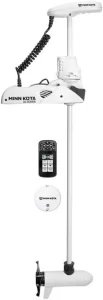 |
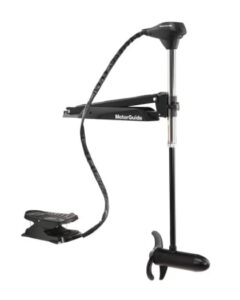 |
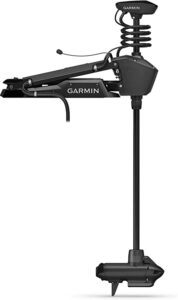 |
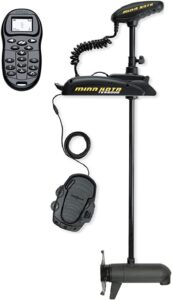 |
| Water Compatibility: Saltwater | Water Compatibility: Freshwater | Water Compatibility: Freshwater, saltwater, and brackish | Water Compatibility: Freshwater |
| Thrust: 80 lbs / 112 lbs | Thrust: 45 lbs / 55 lbs / 70 lbs | Thrust: 80 lbs., 100 lbs. | Thrust: 55 lbs / 80 lbs / 112 lbs |
| Voltage: 24V / 36V | Voltage: 12 V / 24 V | Voltage: 24 V / 36 V | Voltage: 12 V / 24 V / 36 V |
| Speed Control: Variable | Speed Control: 5 forward, 2 reverse / 5-speed/variable | Speed Control: 20 power settings | Speed Control: Variable |
| Control Type: Foot pedal/i-Pilot wireless remote/app | Control Type: Hand, foot | Control Type: Wireless foot pedal; handheld remote | Control Type: Control Type Foot pedal, remote |
| Mount Type: Bow | Mount Type: Bow, pontoon | Mount Type: Bow | Mount Type: Bow |
| Shaft Length: 54" / 60" / 72" | Shaft Length: 36”, 45”, 50” | Shaft Length: 50", 57" | Shaft Length: 45” / 54” / 60” / 72” |
| Shaft Material: Composite | Shaft Material: Stainless steel, composite | Shaft Material: Fiberglass | Shaft Material: Composite |
| Propeller Type: Weedless Wedge 2 | Propeller Type: 2-blade / 3-blade | Propeller Type: Garmin High-Efficiency Propeller (2 blades) | Propeller Type: 2-blade weedless wedge prop (MKP-32/33) |
| Battery Capacity: N/A | Battery Capacity: Variable | Battery Capacity: Dependent on usage | Battery Capacity: Variable |
| Maximum Amp Draw: 52A / 56A | Maximum Amp Draw: Variable | Maximum Amp Draw: 57 amps, 54 amps | Maximum Amp Draw: 50A/56A/52A |
| Warranty: 2-years - lifetime for shaft | Warranty: 2-year limited warranty | Warranty: 3-year warranty; limited lifetime warranty on the shaft | Warranty: Lifetime (shaft), Limited 2-year (rest of motor) |
| Spot Lock: Yes | Spot Lock: No | Spot Lock: Yes | Spot Lock: Yes |
| Fish Finder Connectivity: Yes (through i-Pilot Link and One-Boat Network) | Fish Finder Connectivity: No | Fish Finder Connectivity: Yes | Fish Finder Connectivity: Yes (Humminbird with i-Pilot Link) |
| Best Price (Amazon) Best Price (Bass Pro) | Best Price (Amazon) Best Price (Bass Pro) | Best Price (Amazon) | Best Price (Amazon) |
FRESHWATER
With its cable-steering feature, the Ultrex gives you unparalleled precision in freshwater. It’s particularly good for shallow water anglers, and its propeller absolutely powers through heavy grass. With features like i-Pilot Link offering excellent networking and Spot-Lock with Jogging, this is the best all-around freshwater trolling motor on the market.
SALTWATER
The Riptide Ulterra is one of the most feature-dense motors on the market—saltwater or otherwise. With Spot-Lock and Jogging, Auto Deploy, a powerful GPS, and a corrosion-resistant body, it’s our favorite saltwater trolling motor by a mile. Operating a trolling motor in harsh saltwater conditions requires specialized construction and considerations. Be sure to read our guide covering the best trolling motors for saltwater usage.
LOUDNESS
There’s a reason Lowrance named this motor the Ghost—it’s brushless motor is ultra-quiet. The motor doesn’t sacrifice anything in the way of features or power, either. Tired of scaring fish? The Ghost is the perfect motor for you.
KAYAKS
The MotorGuide Xi3 is lightweight, powerful, and designed for kayaks. With GPS features, a wireless remote, quiet operation, and a system that makes it easy to stow and deploy, it’s our top pick for anyone who wants to troll in their kayak. Kayaks have unique requirements when it comes to trolling motors. Be sure to check out our comprehensive guide to the best trolling motors for kayaks for more information on finding the ideal motor to enhance your kayak's performance.
PONTOONS
A transom-mounted trolling motor designed for pontoons, Newport Vessels offers one of the most powerful transom-mounted motors—perfect for most pontoons. The motor is designed to withstand both saltwater and freshwater, and its telescopic handle is easy to use, making it a great choice for even inexperienced anglers—and our pick for the best pontoon trolling motor. Pontoon boats have unique requirements when selecting a trolling motor. Be sure to read our guide to finding the best trolling motor for pontoon boats for more information on the specialized features and considerations for pontoon applications.
The Best Electric Trolling Motor
All of our favorite trolling motors are electric trolling motors—the Garmin Force is here because it’s one of the most efficient electric trolling motors on the market. Tons of features, including auto-pilot, anchor lock, and more—all with lower power consumption than its competitors. It’s a Force to be reckoned with! When shopping for an electric trolling motor, be sure to check out our guide covering the key factors like power, efficiency, control, mounting, and durability to select the best electric trolling motor for your usage.
The Best Transom-Mount Trolling Motor
The R5 is simple, powerful, and affordable. The mounting mechanism clamps securely to the transom of your boat, and its construction is solid. There aren’t a lot of bells and whistles on the R5, but it is available in both freshwater and saltwater models, and it works on a wide variety of different vessels—it is, without a doubt, our favorite transom-mount motor. Transom mounted trolling motors have unique advantages and considerations compared to bow mount models. Check out our comprehensive guide to selecting the best transom mounted trolling motor for your boat.
The Best Trolling Motor With Spot-Lock
The Minn Kota Terrova is one of the original Spot-Lock motors—and it’s still our favorite. The 24/36 V model offers you variable power, and with all the features you’d expect, like AutoPilot and Jogging, along with a new brushless design, it’s one of the best trolling motors on the market. If spot lock technology is important to you, be sure to check out our guide to selecting the best trolling motors with Spot-Lock for precision GPS anchoring and positioning. We cover key factors like spot lock strength, electronics integration, and enhanced control features.
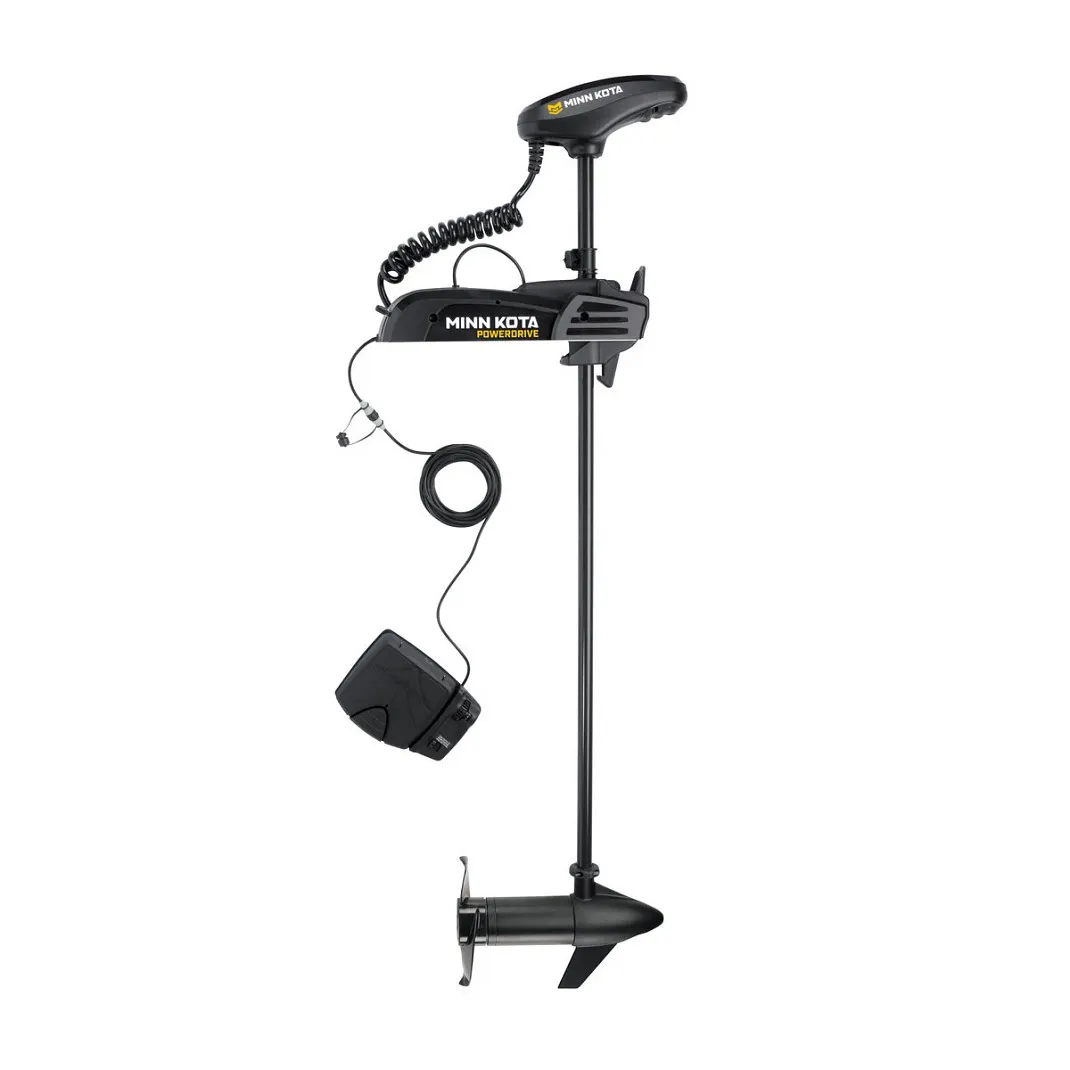
Anglers should know about three different types of trolling motors:
Engine-mounted trolling motors have fallen largely out of favor. Most manufacturers have dropped them—they’re harder to steer with, somewhat tricky to install, and often negatively affected by chop and wind. We’d recommend avoiding them.
Transom-mounted motors are generally less expensive than their bow-mounted counterparts. They’re easy to install and easy to remove. They’re usually steered through a telescopic handle. Conversely, they tend to offer less power and fewer features than bow-mount trolling motors, and they attach less securely to your boat.
Bow-mount trolling motors are the most powerful and feature-dense trolling motors available. They’re often equipped with features like GPS anchoring (Spot-Lock), AutoPilot, and networking capabilities. They attach more securely than any other style of motor. Bow-mount motors are the most difficult to install; they also tend to be the most expensive, the heaviest, and the most difficult to remove from your boat.
You don’t necessarily need the most powerful trolling motor—you only need the right size trolling motor for your boat.
Trolling motors are measured in pounds of thrust—the more pounds of thrust a trolling motor has, the bigger the vessel it can move. Typically, trolling motors range anywhere from 30 pounds of thrust to over 100 pounds of thrust. Minn Kota—maker of many of our favorite trolling motors—has a trolling motor size guide that we highly recommend you look at. The guide should help you choose the right trolling motor for your boat’s size.
Most trolling motors can be controlled in one of four ways:
Telescopic handles are traditionally found on transom-mounted trolling motors. They can be swiveled to change the direction of the boat. Rotating the handle clockwise will move the boat forward—the more you rotate it, the more power the motor will output, and the faster the boat will go. Rotating the handle backwards will send the boat in reverse. Telescopic handles are very easy to use, but they typically don’t offer the same level of nuance as other control methods.
Foot pedals are the most common control system for bow-mount trolling motors. The most traditional style of foot pedal control is heel-toe, in which pressing down with your heel steers the motor left while pressing down with your toe steers it to the right. On feature-dense trolling motors, the foot pedals will often come equipped with buttons for GPS anchoring, auto-pilot, and more.
There are typically two ways of connecting foot pedals—wireless and cable-steered. Cable-steered foot pedals offer much greater precision, but there’s a limit to how far away you can be from your motor while steering it. Wireless foot pedals, on the other hand, offer a greater range but more connectivity issues and slightly less precision.
Wireless remotes are generally only seen on feature-dense bow-mounted motors. They offer less precision than foot pedals but give you access to all of the features on your trolling motor. We tend to use foot pedals when we need precise, active steering and wireless remote control when we’re using features like GPS anchoring and auto pilot.
Finally, apps vary in quality and design depending on the manufacturer. We don’t tend to use apps for motor control, but manufacturers like Minn Kota do a pretty good job—you can connect motors from big-name brands with the fish finders made by those companies and control everything from a single spot on your boat.
Heel-toe foot pedals are our favorite control method—they leave your hands free for fishing—but every angler has their own preference. No wrong answers here!
There are a ton of additional features advertised by trolling motor manufacturers; we’re going to focus on the ones that most anglers care about:
GPS functionality is one of the most highly sought-out trolling motor features. There’s a variety of different GPS functions you might find, including:
Of these functions, GPS anchoring and jogging are the most highly sought-out—they’re perfect for when you’ve found a great fishing spot that you want to stick to, even in high winds and chop. These functions are technically challenging to implement, so trolling motors with GPS functionality are at the highest end of the price spectrum.
The next function to look at is how easy it is to adjust, stow, and deploy your motor. On one end of the spectrum, you have the motors where you have to do everything manually—this includes practically all transom-mounted trolling motors and most bow-mounted trolling motors.
In the middle, you have motors with stow and deploy assist technology (like lift assist)—mechanisms that make it easier to lift your motor. For top-of-the-line mobility features, the Minn Kota Ulterra is impossible to beat, with Auto Stow and Deploy, as well as automatic trimming.
Quick-release brackets are a key feature for bow-mounted trolling motors—you’ll want to install your motor using one of these brackets to make it easy to remove when not in use. Many trolling motors don’t come with quick-release brackets, but most manufacturers sell them.
Finally, anglers who are looking for a high-tech setup on their boat should prize wireless connectivity. Many modern trolling motors can connect to your phone, your fish finder, and other equipment you may have. Typically, big brands like Minn Kota, Lowrance, and Garmin are the best when it comes to wireless functionality.
Below, we give our picks for our favorite motors in the most common price ranges. These motors are based on some of our personal preferences, and the $1000+ category is particularly contested. Want the quietest motor possible? Go with the Ghost. Want Auto Stow and Deploy? Go with the Ulterra. Keep your preferences in mind at each price point—there are a ton of excellent motors available.
This is a transom-mounted trolling motor built for kayaks and small canoes. This motor is incredibly affordable, and the construction and quality of the motor are legitimately unbelievable for the price.
The PowerDrive has a ton of features, including built-in sonar, GPS, and stow and deploy assist. You’d be hard-pressed to find such another motor with that many features at this price range, and it’s built with the quality and care we’ve come to expect from Minn Kota.
For our money, the Ultrex is the best trolling motor on the market. Tons of features, a super responsive foot pedal, amazing construction, and quiet operation. We love it, and we think you will too.
If shopping on a tight budget, be sure to check out our guide to selecting the best cheap trolling motors - we cover maximizing value and performance at lower price points.
There are a lot of excellent trolling motors on the market. Here are the factors we consider the most important:
Our favorite motor is the Minn Kota Ultrex —the runner-up for freshwater motors is the Lowrance Ghost, and our favorite budget motor is the Newport Vessels Kayak motor. We highly encourage you to read all of our motor reviews—you’re bound to find the one that’s right for you!
The thrust you need in your trolling motor depends on the weight and length of your boat. To help you find the right size, we recommend the trolling motor size guide created by Minn Kota.
Always consult the owner’s manual (you can find them online before purchasing your trolling motor) to know which batteries to use. Typically, trolling motors are found in 12V, 24V, and 36V varieties. This means you’ll need 1 to 3 12V batteries. Almost all manufacturers recommend deep-cycle marine batteries; choosing batteries with higher Ah ratings will keep you out on the water for longer. Be sure to use the right size battery for your specific trolling motor's power demands.
Shaft length varies depending on the distance from your bow or transom to the waterline. This trolling motor size guide by West Marine should help you to determine what shaft length you’ll need.
Proper installation depends on the type of trolling motor—transom-mount trolling motors are typically much easier to install than bow-mount trolling motors. You’ll need power tools, wrenches, and more to install a bow-mount trolling motor. We recommend reading installation guides—you’ll also need to know how to build a circuit with batteries and circuit breakers. Higher voltage setups like 24V trolling motors require special wiring considerations for proper performance and safety. Be sure to do some reading on how to wire a 24V trolling motor.
This depends on the max amp draw of your motor and the amp hour (Ah) rating of your battery. Most motors have a max amp draw of around ~50 amps, but you won’t be using your trolling motor at full power at all times while you’re out on the water. Typically, you’ll want to choose a battery with a 100+ Ah rating—this gives you approximately 2 hours of full power trolling.
We always recommend getting a quick-release bracket for bow-mount trolling motors. You may also want to purchase a fish finder to connect with your trolling motor if it has networking capacities.
Upgrading an old trolling motor is typically as easy as taking it off your boat, and buying a new trolling motor, then installing the new one. When you already have a quick-release bracket installed on your boat, it makes it even easier to install a new trolling motor; just be sure that it has enough clearance with your current bracket setup.
Whisper quiet. The quietest trolling motors purr instead of roaring and are unlikely to scare away many fish.
Spot-Lock is actually a proprietary term for GPS anchoring. GPS anchoring is a technology which keeps your boat in place by using GPS in tandem with your trolling motor to automatically correct for wind, chop, and other environmental factors that would cause your boat to drift.
Whisper quiet. The quietest trolling motors purr instead of roaring and are unlikely to scare away many fish.
“Worth it” always depends on what you’re looking for. The most expensive trolling motors come with higher thrust and more powerful features like GPS anchoring and wireless connectivity. For enthusiasts and professionals, the higher costs are often well worth the functionality.
Our favorite trolling motors are made by:
We don’t recommend engine-mount trolling motors. Transom-mount trolling motors tend to be best for smaller boats—think canoes, kayaks, and small pontoon boats. Bow-mount trolling motors are best for larger boats—they’re also best if you’re looking for a trolling motor with a lot of features.